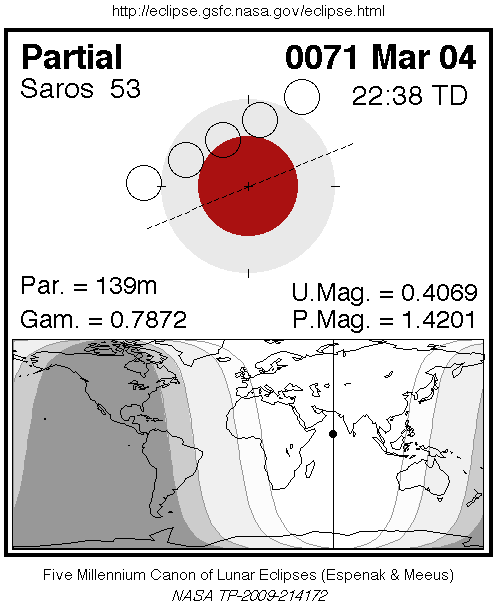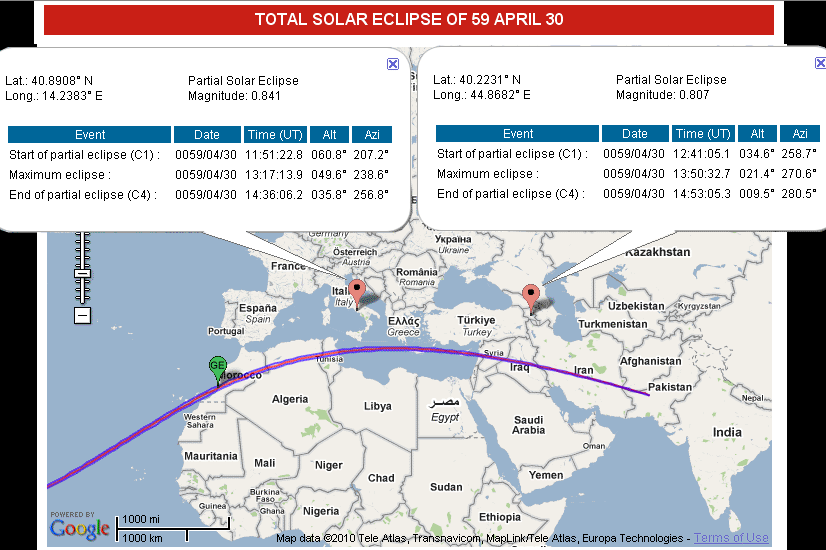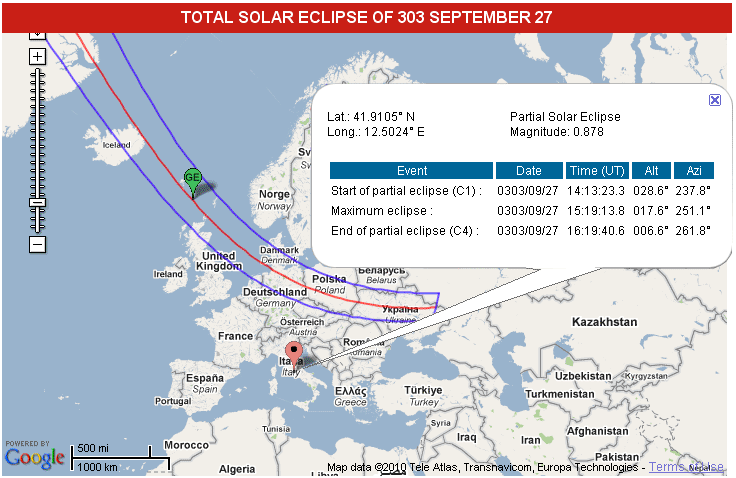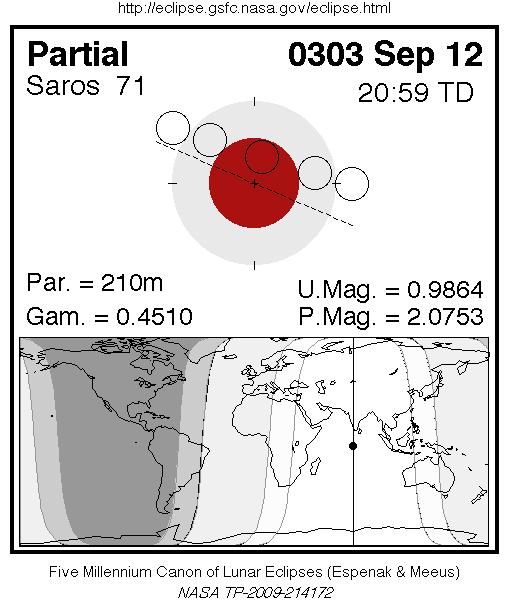These are the dated astronomical observations from Pliny the Elder's "Natural History" (ref.1,2):
- ... The eclipse of both sun and moon within 15 days of each other has occurred even in our time, in the year of the third consulship of the elder Emperor Vespasian and the second consulship of the younger.
- ... The eclipse of the sun which occurred the day before the calends of May, in the consulship of Vipstanus and Fonteius a few years ago, was visible in Campania between the seventh and eighth hour of the day but was reported by Corbulo commanding in Armenia as observed between the tenth and eleventh hour.
The consul years above have been connected to:
(about year count and notation read explanation here, opens in new tab)
- RomAD 71 as the year of the third consulship of the elder Emperor Vespasian and the second consulship of the younger and
- RomAD 59 as the consulship of Vipstanus and Fonteius
For observation 1. we are looking for a (without telescope) observable solar eclipse at 15 days distance from an observable lunar eclipse, presumably in Rome or Campania.
For observation 2. we are looking for a solar eclipse occurring 12 years before observation 1. at new moon in May and observable in Campania in the afternoon and in Armenia somewhat before sunset (ref.3).
The commonly agreed to datings and corresponding eclipses can be verified with the NASA Eclipse Web Site:

Fig.1.: The commonly agreed to solar eclipse corresponding to observation 1. above. The solar eclipse with its magnitude of 80% is indeed observable in Rome or Campania.

Note: Ref.1, p 260: "quindecim diebus" (fifteen days). In French, two weeks are normally said to be fifteen days. So we might question the precision of an observation saying 15 days. However, we also might wonder if 16 days is the same as 15 days.

Fig.3.: The commonly agreed to solar eclipse corresponding to observation 2. above.
Drawbacks of the commonly agreed to alternative:
- 16 days between the solar and lunar eclipses instead of 15 as reported.
- A lunar eclipse with an umbral magnitude of only 0.4 which makes it not too apparent for a casual observation.
Looking for alternative datings
With help of the NASA Eclipse Web Site we have created lists of solar eclipses from Rome and Naples in Italy and from Jerevan in Armenia covering the time 1 to 500.
From the Rome list we have considered all eclipses with a magnitude above 0.5 and an altitude above 5 degrees at maximum. For each such solar eclipse we have looked up a corresponding list of lunar eclipses and selected all partial or total with an umbral magnitude above 0.1 and within an interval of 13 to 16 days before and after a solar eclipse. There are 38 solar eclipses in that time span which fulfill these conditions.
For each such a solar/lunar eclipse pair we have looked for a solar eclipse exactly 12 years before visible in both Jerevan and in Naples. There are three solar/lunar eclipse pairs which also have a solar eclipse 12 years before only in Armenia, and one that has such an eclipse only in Naples. There are six solar/eclipse pairs that have a solar eclipse 12 years before in both Armenia and Naples. Four of these are not at sunset in Armenia!
Remain two possible sets of observations between 1 and 500, of which one is the commonly agreed to described above.
The other set is: the solar eclipse of 27 September 303 with a lunar eclipse on 12 September with exactly 15 days distance. The corresponding solar eclipse 12 years before occurred on 15 May 291.
Note: This selection of data was done with a small computer program especially written for this operation. The advantage of doing this extraction of data with a computer program is that the risk of making an error through an oversight is minimized provided that the program has been verified for correctness. (Actually the result was found "by hand" but was then verified with the program.)

Fig.4.: A solar eclipse 232 years later than that commonly agreed to corresponding to observation 1. of Pliny.

Fig.5.: A lunar eclipse 232 years later than that commonly agreed to corresponding to observation 1. of Pliny.
The lunar eclipse is actually total as seen with a naked eye.

Fig.6.: A solar eclipse 232 years later than that commonly agreed to corresponding to observation 2. of Pliny. Please note that the solar eclipse of 15 May 291 may very well correspond to the phrase "the day before the calends of May". The day before the calends, means the day before the start of a new lunar cycle. As a solar eclipse implies that the moon is standing between the earth and the sun this also implies the start of a new lunar cycle.
With the problem of possibly having to remove some 200 years from our calendar, it is tempting to propose that Pliny actually lived in a time where he could observe the alternative eclipses shown in figures 4 to 6.
The consulship of Vipstanus and Fonteius corresponds to RomAD 59, see above. To make RomAD 59 the same as year 291 we have to remove 232 years out of our current calendar. That would imply that Pliny lived in Astr 255 to 311 instead as commonly agreed to in RomAD 23 to 79.
References:
1. Caii Plinii Secundi Historiæ naturalis libri xxxvii on Pliny on Google books
2. Pliny, Natural History, Book 2, chapter 10 and 72, trans. Rackham read here However, we inserted own translations of dates and timings from Latin because Rackham's statements contain too much interpretation. E.g. he translates pridie Calendas Maias with "April 30", and inter horam diei decimam et undecimam with "between 4 and 5 p.m".
3. Wikipedia on Planetary hours
